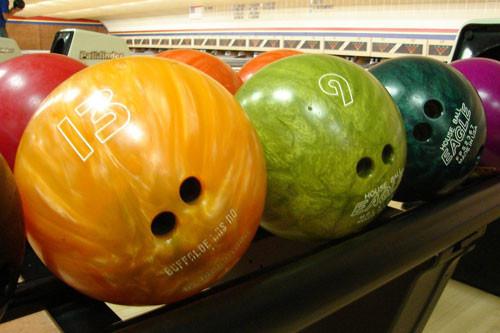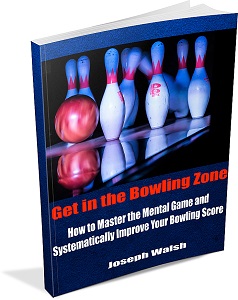When it comes to bowling ball sizes, you’ll find that both the size and weight of the balls are important.
We’ll talk about both here, especially since the size of a bowling balls is often dictated by the variety of bowling you’re playing, so it’s useful to go into bowling ball weights and what they mean too.
We’re sure we don’t need to tell you the importance of having a bowling ball that fits your hands and is comfortable to swing and throw.
Many casual bowlers grab bowling balls from the rack that are too heavy for them and negatively impact their performance.
One size does not fit all where bowling is concerned and, whether you want to impress at a casual game or not let the team down, it’s wise to know which size bowling balls are best for you.
Bowling Ball Sizes
First, we should break down the different sizes of bowling balls that you’ll see out in the wild. When most people hear bowling, they think of ten-pin bowling, and for good reason. Ten-pin bowling is the most popular by far, but there are alternative bowling styles that have their own, differently sized balls.
These range from the standard ten-pin balls to duckpin, five-pin, and candlepin balls.
Ten-Pin Bowling Balls
We’ll start with the ten-pin balls since they’re the ones that’ll apply to most readers. If you haven’t noticed, all of the sizes we’ve mentioned are tied to specific bowling game types, meaning that most of the sizes are subject to regulations and specifications that are tied to those games.
This is, of course, the case with ten-pin bowling balls. Ten-pin bowling is regulated by the USBC in the States and World Bowling internationally.
The USBC specifications require that a ten-pin ball weigh less than 16 pounds and have a diameter of 8.500 to 8.595 inches, or 21.59 to 21.83 centimeters.
This is a pretty narrow window in which different sizes of ten-pin balls can exist, and the specifications don’t stop there with thumb hole size, surface hardness and roughness, and performance characteristics like radius of gyration are also mandated.
Duckpin Bowling Balls
Duckpin bowling is a variation of bowling where you strike shorter, squatter bowling pins with a smaller ball. How much smaller, you ask?
Duckpin bowling balls are just 3.6 to 3.12 pounds and 12 to 12.7 centimeters in diameter. They also lack holes since the balls are small enough for you to get sufficient grip without them. Duckpin balls are regulated by the National Duckpin Bowling Congress, or NDBC, in the nine eastern states where duckpin bowling is played.
Besides the obvious differences in size, duckpin bowling functions much the same as ten-pin bowling and is often seen as a space-efficient casual alternative for indoor play areas.
Five-Pin Bowling Balls
Five-pin bowling is exactly what it sounds like, bowling where there are only five pins that you must strike.
The balls used, however, are similar in size to duckpin balls. They weigh the same, from 3.6 to 3.12 pounds, and are 12.1 to 12.7 in diameter with no finger holes.
Candlepin Bowling Balls
Candlepin bowling balls are the smallest kind of bowling ball, and you may be familiar with how candlepin bowling is played if you’ve spent time in New England and the easternmost provinces of Canada.
Using the tiny bowling ball that fits in the palm of your hand, you need to knock down long but narrow bowling pins that resemble candles more than the traditional pin.
Each ball weighs between 2.4 and 2.7 pounds, which is the average weight of just one candlepin. This makes it much more difficult to knock the pins down, and precision is even more important because of how narrow they are.
As for diameter, the balls are 4.5 inches, or 11 centimeters, which is almost half the 8.5-inch average that ten-pin bowling balls sit at.
Why is Bowling Ball Weight Important?
So, we’ve established that you have little control over the actual size of a bowling ball when you’re playing a proper game. The size is usually determined by the type of bowling you’re playing instead, and the range of allowed sizes is often very strict.
Weight is a more important factor in improving your bowling performance.
With the right weight, you can achieve a more consistent throwing speed that gives you a foundation to start honing your game. Otherwise, if the ball you’re using is too heavy for you, you’ll lose speed when throwing and won’t get the momentum you need.
Likewise, a ball that’s too light will lack the force you need and may be harder to control if you’re not taking its weight into account when throwing it.
You should always lean towards having the heaviest ball that’s comfortable for you since a higher mass generates more speed. This means you get more impact when hitting the pins, which is ideal for getting those all-important strikes.
In order for the momentum and speed of the ball to be in perfect balance, however, you need to get the weight that’s right for you.
The faster your natural throwing speed, the better you’ll be switching to lighter weights so that you can control that speed and have a more consistent performance. For example, say you throw at around 20 miles-per-hour but the heaviest ball, a 16 pounder, cuts that number down to 14 miles-per-hour.
To calculate the momentum by multiplying these together, 16 x 14 = 224. Now, if your throwing speed remains at 20 mph but you use a lighter ball, like a 14-pound ball that enables you to throw at 17 mph, then you’re looking at 14 x 17 = 238, getting more momentum out of a lighter ball.
When Do You Need to Change Your Bowling Ball Weight?
How do you judge when a ball is too heavy or light? This is something that beginners may struggle with since they haven’t developed that sense or taste for a consistent and predictable bowl is.
It’s something that comes with experience, but there are certain things you can keep an eye out for throughout the night.
If a ball is too heavy for you, you’ll find yourself getting fatigued or maybe even hurting in your arm by the end of the night.
This shouldn’t be happening and is usually a sign that the ball you’re using isn’t a suitable weight for you to play with. The pain can be in your arm, specifically the elbow, as well as the wrist, shoulder, and back.
As the night goes on, you may also notice that the ball gets slower as it becomes more and more taxing to cast it down the alley.
It is possible to “grow into” a heavier ball by becoming accustomed to lifting and throwing the heavier weight, but this is something you should work towards. You wouldn’t begin strength training by piling weights on yourself, you need to build up to it first.
You shouldn’t keep using an unsuitable ball in the hopes that it’ll get better with time, instead use other weight training methods to make lifting heavier balls easier.
A lighter ball may be less obvious to detect since it usually results in a lackluster pin impact and a general lack of control over where the ball is going. If you find that throwing the ball is a little too easy, then your ball may be too light.
You should still feel the weight of a ball when you throw it without that ball hurting your arm.
If any of these problems are present, try experimenting with higher or lower weight classes.
When Have You Found Your Ideal Weight?
If you need to impress at the bowling alley, getting a ball that’s just suitable won’t be enough. You’ll need a ball that’s ideal so that your performance can be at its best. You need a go-to ball, a ball that you know will deliver a satisfying performance when combined with your swing.
This means getting a ball that’s comfortable to swing so that it doesn’t wear you down throughout the game, but not too easy than you can’t appreciate the weight of the ball, whilst being easy to control and predict how it’ll play across the alley once it leaves your hand.
You should reach an ideal weight so that you can generate a great amount of force without overexerting your speed and stamina as the night progresses.
In order to find your ideal weight, you have a few options. As we’ve said above, the trial and error approach is a valid method of determining your ideal weight. It isn’t much to find your local alley and experiment with all the balls until you find the best one in a relatively short amount of time.
That said, there is a mathematical equation you can use to determine the best starting weight for you. You should take your body weight and divide it by eleven, choosing the closest bowling ball weight to the results you get.
You don’t need a degree in mathematics to work that out, so it’s a simple way of getting an approximation of which weight you should be working with.



Leave a Reply